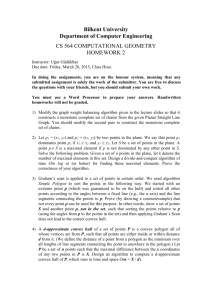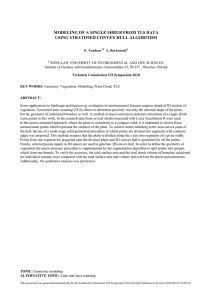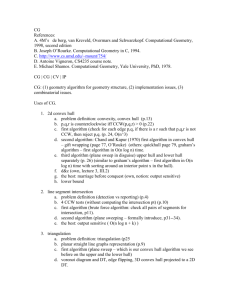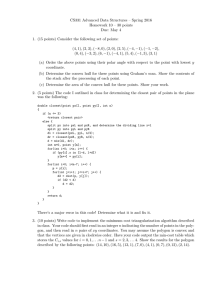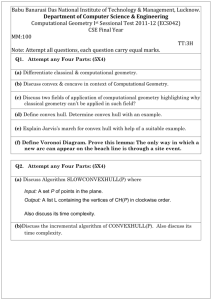Seminar 13 Computational Geometry
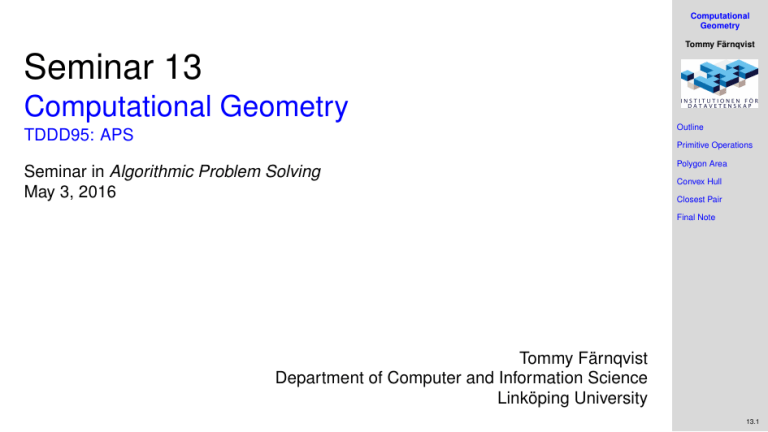
Seminar 13
Computational Geometry
TDDD95: APS
Seminar in Algorithmic Problem Solving
May 3, 2016
Tommy Färnqvist
Tommy Färnqvist
Department of Computer and Information Science
Linköping University
13.1
Outline
1
2
3
4
Tommy Färnqvist
13.2
Geometric Primitives
• Point: two numbers ( x , y ) .
• Line: two numbers a and b .
[ ax + by = 1 ]
• Line segment: two points.
• Polygon: sequence of points.
Primitive operations
• Is a polygon simple?
• Is a point inside a polygon?
• Do two line segments intersect?
• What is the Euclidean distance between two points?
• Given tree points p
1
, p
2
, p
3
, is p
1
→ p
2
→ p
3 a counterclockwise turn?
Tommy Färnqvist
13.3
Geometric Intuition
Warning: intution may be misleading.
• Humans have spatial intuition in 2D and 3D.
• Computers do not.
• Neither has good intuition in higher dimensions!
Q.
Is a given polygon simple? (No crossings.)
Tommy Färnqvist
13.4
Polygon inside, outside
Theorem (Jordan curve theorem, Jordan 1886, Veblen 1905)
Any continuous simple closed curve cuts the plane in exactly two pieces: the inside and the outside.
Q.
Is a point inside a simple polygon?
Tommy Färnqvist
13.5
Polygon inside, outside: crossing number
Tommy Färnqvist
13.6
Implementing ccw
CCW.
Given three points a , b , and c , is a → b → c a counterclockwise turn?
• Analog of compares in sorting
• Idea: compare slopes
Tommy Färnqvist
Lesson.
Geometric primitives are tricky to implement.
• Dealing with degenerate cases.
• Coping with floating-point precision.
13.7
Implementing ccw
CCW.
Given three points a , b , and c , is a → b → c a counterclockwise turn?
• Determinant gives twice signed area of triangle.
• If area > 0 then a → b → c is counterclockwise.
• If area < 0 then a → b → c is clockwise.
• If area = 0 then a → b → c are collinear.
Tommy Färnqvist
13.8
Immutable Point Data Type
Tommy Färnqvist
13.9
Sample ccw client: line intersection
Intersect.
Given two line segments, do they intersect?
• Idea 1: find intersection point using algebra and check.
• Idea 2: check if the endpoints of one line segment are on different “sides” of the other line segment (4 calls to ccw).
Tommy Färnqvist
13.10
Area of Polygons
Area.
The area of any simple polygon is given by the following formula
A = n
X k = 0
( x k + 1
+ x k
)( y k + 1
2
− y k
)
, where n is the number of vertices, ( x k
, y k
) is the k th point when labelled in a counterclockwise manner, and ( x n + 1
, y n + 1
) = ( x
0
, y
0
) .
Example
A = n
X
( x k + 1
+ x k
)( y k + 1
− y k
)
2 k = 0
=
( 1 .
5 + 0 )( 0 − 0 )
+
+
2
+
( 2 .
5 + 1 .
5
2
)( − 1 − 0 )
+
( 3 .
= 0 + ( − 2 ) + 3 + 0 + 10 + 0 + 3 + ( − 2 ) + 0 + 0
5 + 2 .
5 )(
2
0
( 5 + 5 )( 2 − 0 )
+
2
( 1 .
5 + 2 .
5 )( 2 − 3 )
( 3 .
5 + 5 )( 2 − 2 )
2
+
+
( 0 + 1 .
5 )( 2 − 2 )
2 2
( 2 .
5 + 3 .
5 )( 3 − 2 )
+
( 0 +
2
0 )(
2
0 − 2 )
− ( − 1 ))
+
( 5 + 3 .
5 )( 0 − 0 )
2
= 12
Area of Polygons
Area.
The area of any simple polygon with vertices at integer coordinates is given by Pick’s theorem:
R
A = I + − 1 ,
2 where R is the number of integer points on the boundary of the polygon, and I is the number of integer points in the interior of the polygon.
Example
Tommy Färnqvist
Here, R = 12, and I = 40, which means the area of the polygon is 40 + 6 − 1 = 45.
13.12
Convex Hull
A set of points is convex if, for any two points p and q in the set, the line segment pq is completely in the set.
Convex hull.
Smallest convex set containing all the points.
Tommy Färnqvist
• Shortest (perimeter) fence surrounding the points.
• Smallest (area) convex polygon enclosing the points.
13.13
Mechanical Solution
Tommy Färnqvist
Mechanical convex hull algorithm.
Hammer nails perpendicular to the plane; stretch elastic rubber band around points.
13.14
Brute-force Algorithm
Observation 1.
Edges of convex hull of P connects pairs of points in P .
Observation 2.
p q is on convex hull of all other points are counterclockwise of
−
.
Tommy Färnqvist
O ( N 3 ) algorithm.
For all pairs of points p and q :
• Compute Point.ccw(p, q, x) for all other points x .
• p → q is on hull if all valules are positive.
Degeneracies.
Three (or more) points on a line.
13.15
Package Wrap (Jarvis March)
•
•
•
•
Start with point with smallest y -coordinate.
Rotate sweep line aroung current point in the ccw direction.
First point hit is on the hull.
Repeat.
Tommy Färnqvist
13.16
Package Wrap (Jarvis March)
• Compute angle between current point and all remaining points.
• Pick smallest angle larger than current angle.
• Θ( N ) per iteration.
Tommy Färnqvist
13.17
How Many Points on the Hull?
Parameters.
• N = number of points.
• h = number of points on the hull.
Package wrap running time.
Θ( Nh ) .
How many points on the hull?
• Worst case: h = N .
• Average case: difficult problems in stochastic geometry.
•
• uniformly at random in a disc: h = N
1 / 3 uniformly at random in a convex polygon with O ( 1 ) edges: h = log N
Tommy Färnqvist
13.18
Graham Scan
• Choose point p with smallest y -coordinate.
• Sort points by polar angle with p to get (simple) polygon.
• Consider points in order, and discard those that would create clockwise turn.
Tommy Färnqvist
13.19
Graham Scan: Implementation
• Input: p[1], p[2], ..., p[N] are distinct points (not all collinear).
• Output: M and rearrangement so that p[1], p[2], ..., p[M] is convex hull.
Tommy Färnqvist
Running time.
N log N for sort and linear for rest. (Why?)
13.20
Quick Elemination
Quick elimination.
• Choose a quadrilateral Q or rectangle R with 4 points as corners.
• Any point inside cannot be on hull.
•
•
4 ccw tests for quadrilateral
4 compares for rectangle
Three-phase algorithm.
• Pass through all points to compute R.
• Eliminate points inside R.
• Find convex hull of remaining points.
In practice.
Eliminates almost all points in linear time.
Tommy Färnqvist
13.21
Closest Pair
Tommy Färnqvist
Closest pair problem.
Given N points in the plane, find a pair of points with the smallest Euclidean distance between them.
Brute force.
Check all pairs with N 2 distance calculations.
1d version.
Easy N log N algorithm if points are on a line.
Non-degeneracy assumption.
No two points have the same x -coordinate.
13.22
Divide-and-conquer Algorithm
Tommy Färnqvist
13.23
Divide-and-conquer Algorithm
Tommy Färnqvist
13.24
Divide-and-conquer Algorithm
Tommy Färnqvist
13.25
Divide-and-conquer Algorithm
Tommy Färnqvist
13.26
Divide-and-conquer Algorithm
Tommy Färnqvist
13.27
Divide-and-conquer Algorithm
Tommy Färnqvist
13.28
Divide-and-conquer Algorithm
Tommy Färnqvist
13.29
Divide-and-conquer Algorithm
Tommy Färnqvist
13.30
Divide-and-conquer Algorithm
Tommy Färnqvist
13.31
Divide-and-conquer Algorithm
Tommy Färnqvist
13.32
Next time
Combinatorics/Probability theory. . .
Tommy Färnqvist
13.33
